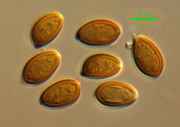Home / Shop
Psilocybe Subaeruginosa Spore Swabs










- Description
Psilocybe subaeruginosa was first described in 1927 by Australian mycologist John Burton Cleland.[4] The species name refers to the colour of the blueing reaction when the fruitbodies are damaged or handled - the feminine Latin adjective aeruginosa describes copper rust, which is verdigris or blue-green.
A type collection was not formally designated by Cleland, and the collection examined later by Guzman and Watling and called the type, with distinctive brown cystidia,[8] is missing from Cleland's collections in Adelaide. A formal lectotype from Belair National Park Australia has since been designated[1] (AD 5603/Cleland 13256) but without details of habitat and substrate, making an authentic concept of the species difficult to verify.
A 1992 study comparing the morphology and mating compatibility of P. australiana, P. eucalypta, P. subaeruginosa and P. tasmaniana suggested the four were synonymous and proposed combining them as P. subaeruginosa.[1] The idea was rejected by the authors of the later species, Gastón Guzmán calling the comparisons "confused" and reprinting descriptions the same year.[9] Despite this objection the proposal was accepted in 1995, with the exception of P. tasmaniana, which was excluded for having characteristics that did not suit the synonymy, and the specimen examined as P. tasmaniana being misidentified.[5]